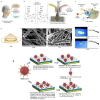Biomedical Applications of Antiviral Nanohybrid Materials Relating to the COVID-19 Pandemic and Other Viral Crises
- PMID: 34451371
- PMCID: PMC8401873
- DOI: 10.3390/polym13162833
Biomedical Applications of Antiviral Nanohybrid Materials Relating to the COVID-19 Pandemic and Other Viral Crises
Abstract
The COVID-19 pandemic has driven a global research to uncover novel, effective therapeutical and diagnosis approaches. In addition, control of spread of infection has been targeted through development of preventive tools and measures. In this regard, nanomaterials, particularly, those combining two or even several constituting materials possessing dissimilar physicochemical (or even biological) properties, i.e., nanohybrid materials play a significant role. Nanoparticulate nanohybrids have gained a widespread reputation for prevention of viral crises, thanks to their promising antimicrobial properties as well as their potential to act as a carrier for vaccines. On the other hand, they can perform well as a photo-driven killer for viruses when they release reactive oxygen species (ROS) or photothermally damage the virus membrane. The nanofibers can also play a crucial protective role when integrated into face masks and personal protective equipment, particularly as hybridized with antiviral nanoparticles. In this draft, we review the antiviral nanohybrids that could potentially be applied to control, diagnose, and treat the consequences of COVID-19 pandemic. Considering the short age of this health problem, trivially the relevant technologies are not that many and are handful. Therefore, still progressing, older technologies with antiviral potential are also included and discussed. To conclude, nanohybrid nanomaterials with their high engineering potential and ability to inactivate pathogens including viruses will contribute decisively to the future of nanomedicine tackling the current and future pandemics.
Keywords: COVID-19; biomedical application; nanocomposite; nanohybrid.
Conflict of interest statement
The authors declare no conflict of interest.
Figures









Similar articles
-
Toward Nanotechnology-Enabled Approaches against the COVID-19 Pandemic.ACS Nano. 2020 Jun 23;14(6):6383-6406. doi: 10.1021/acsnano.0c03697. Epub 2020 Jun 10. ACS Nano. 2020. PMID: 32519842 Review.
-
Nanofiberous facemasks as protectives against pandemic respiratory viruses.Expert Rev Respir Med. 2024 Mar-Apr;18(3-4):127-143. doi: 10.1080/17476348.2024.2356601. Epub 2024 May 22. Expert Rev Respir Med. 2024. PMID: 38753449 Review.
-
Nanoscience and quantum science-led biocidal and antiviral strategies.J Mater Chem B. 2021 Sep 22;9(36):7328-7346. doi: 10.1039/d0tb02639e. J Mater Chem B. 2021. PMID: 34378553 Review.
-
Emerging Applications of Biomedical Science in Pandemic Prevention and Control: A Review.Cureus. 2023 Aug 24;15(8):e44075. doi: 10.7759/cureus.44075. eCollection 2023 Aug. Cureus. 2023. PMID: 37750154 Free PMC article. Review.
-
Applications of nanomaterials in COVID-19 pandemic.Rare Metals. 2022;41(1):1-13. doi: 10.1007/s12598-021-01789-y. Epub 2021 Sep 15. Rare Metals. 2022. PMID: 34539132 Free PMC article. Review.
Cited by
-
Electrostatic Spray Disinfection Using Nano-Engineered Solution on Frequently Touched Surfaces in Indoor and Outdoor Environments.Int J Environ Res Public Health. 2022 Jun 13;19(12):7241. doi: 10.3390/ijerph19127241. Int J Environ Res Public Health. 2022. PMID: 35742489 Free PMC article.
-
Antiviral polysaccharide and antiviral peptide delivering nanomaterials for prevention and treatment of SARS-CoV-2 caused COVID-19 and other viral diseases.J Control Release. 2023 Jun;358:476-497. doi: 10.1016/j.jconrel.2023.05.010. Epub 2023 May 14. J Control Release. 2023. PMID: 37164241 Free PMC article. Review.
-
Biodegradable Nanohybrid Materials as Candidates for Self-Sanitizing Filters Aimed at Protection from SARS-CoV-2 in Public Areas.Molecules. 2022 Feb 16;27(4):1333. doi: 10.3390/molecules27041333. Molecules. 2022. PMID: 35209122 Free PMC article.
-
Nature-Derived and Synthetic Additives to poly(ɛ-Caprolactone) Nanofibrous Systems for Biomedicine; an Updated Overview.Front Chem. 2022 Jan 19;9:809676. doi: 10.3389/fchem.2021.809676. eCollection 2021. Front Chem. 2022. PMID: 35127651 Free PMC article. Review.
References
Publication types
LinkOut - more resources
Full Text Sources

